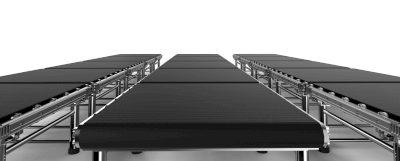What Is Conveyor Belting?

Conveyor belting is a belt used in conveyor belts. They can be made of resin, metal, or rubber.
Installed with conveyor belts in factories, etc., conveyor belts receive the drive torque of the conveyor motor and carry all kinds of objects on the belt. Various treatments, such as antibacterial, antifungal, anti-static, heat-resistant, non-adhesive, and oil-resistant, are applied depending on the objects conveyed. The shape also varies depending on the conveyor type, such as curved or inclined conveyors.
Uses of Conveyor Belting
Most conveyor belts are installed on the belt portion of the conveyor. They convey various materials, including processed food, pharmaceuticals, paper products such as banknotes and tickets, and even industrial waste.
Resin belts are often used to convey food and pharmaceuticals in sanitary environments and are treated with antibacterial, antifungal, and non-adhesive treatments.
Metal belts have excellent heat resistance, with some belts that can withstand temperatures up to 1,100°C (1,100°F) and are used for drying and cleaning with hot water.
Rubber belts transport earth, sand, crushed stones, ores, sludge, etc.
Characteristics of Conveyor Belting
Resin belts are easy to process and can be treated with various properties such as antibacterial, antifungal, anti-static, waterproof, and non-adhesive. Cutting a groove in the center of the conveyor roll makes it possible to bond the anti-snaking resin to the back of the belt, preventing it from snaking or derailing.
Metal belts are mainly made of wire mesh. Also called a net conveyor, countless wires weave it. The wire mesh allows steam and hot water to pass easily, making it suitable for washing, sterilizing, or cooking products on the belt at high temperatures.
Rubber belts have excellent impact resistance and are suitable for carrying earth, sand, or crushed stones.
In both cases, the conveyor rolls are attached to the inside of the belt and driven by a motor. Conveyor rolls attached to both ends of the belt are pulled together in separate directions to tension the belt and rotate the conveyor rolls, which are driven by the motor, to transmit driving torque to the belt.
Conveyor belting is usually pre-endless and is joined together by welding or welding the ends of the belts together. Since installing or replacing large or long belts is not easy, engineers may go to where the conveyor belt is installed and perform the endless processing directly on-site using a welding machine.
Food Conveyor Belting
Food conveyor belting requires a high level of hygiene management and must meet the standards of HACCP and the Food Sanitation Law. Specifically, they are required to prevent bacteria and mold and to prevent the loosening of ears that may cause foreign objects to enter the belt.
In addition to the above, other performance requirements for conveyor belts depend on the food to be conveyed. For example, excellent release properties are required for sticky food products.
Belt materials include resin materials such as polyurethane and polyester and metal materials such as stainless steel.
Stainless steel conveyor belting, in particular, has excellent durability, corrosion resistance, and resistance to cleaning chemicals. This makes it possible to convey food products that are heated or dried at high temperatures, which is difficult with resin belting and to convey cooled materials at low temperatures. Also, compared to resin belts, the belt is clean and free from the growth of bacteria, and food can be placed directly on the belt.
Canvas Conveyor Belting
Canvas conveyor belting is ideal for various applications, from light to heavy loads, over short to long distances.
The most commonly known canvas conveyor belts consist of coated rubber on both sides of the canvas and a cover rubber (top and bottom surfaces) covering the outside of both coated rubbers.
Multi-layered canvas conveyor belts are also known, consisting of multiple layers of canvas, with adhesive rubber and cushioning rubber placed between the layers of canvas, and covered with cover rubber (top and bottom surfaces) on the outside of the canvas.
Nylon and polyester are the most common canvas materials, and the core is formed by interweaving these materials as warp and weft yarns.
Canvas conveyor belts have high tensile strength and excellent trough and shock absorption properties. It adapts well to carrier rollers and does not meander. The strong adhesive strength prevents delamination between the layers.
Belts with a core made of polyester warp and nylon weft yarns are interwoven. They have an extremely low elongation rate compared to nylon canvas, making them suitable for special applications.